What is EDI (Electronic Data Interchange)?
5 questions and answers for a better understanding on the topic of EDI

What is EDI?
EDI is the abbreviation for the term Electronic Data Interchange. The collective term EDI refers to the structured and IT-supported exchange of business documents between business partners (supplier & customer). Related to classic business processes, these are for example documents such as purchase orders, delivery notifications or invoices. EDI messages can also be master data or industry-related documents. For the energy industry, this includes electricity meter data, and for the retail industry, inventory or price lists. So instead of sending a paper document as in the traditional way, an electronic document is exchanged when using EDI.
One special feature of the exchange of EDI messages is the common agreement on a standard for the structured presentation of the information. The other is the use of a communication channel suitable for regular data exchange.
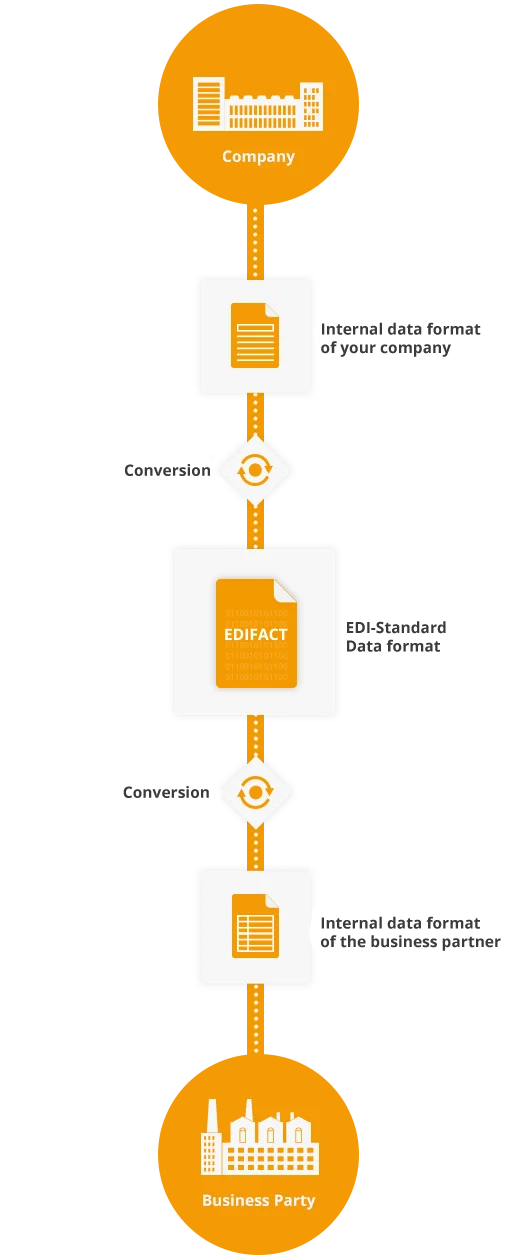
The overriding goal of electronic data interchange is to standardize the regular exchange of business documents on the basis of national or international standards and thus to make them uniform. In simpler terms, data can be exchanged easily and yet securely between companies using uniform rules. The uniform standard, which is independent of the ERP or merchandise management system used or the industry, should enable as many market participants as possible to carry out as many work processes as possible in electronic form with the help of EDI.
The automated processing of EDI messages eliminates the need for manual data entry activities, so that business processes can run much faster and more efficiently. In concrete terms, EDI means that orders, for example, no longer have to be entered manually by a clerk in the system, but the system automatically records this information and processes it using defined rules. In many business relationships, the exchange of EDI documents is common practice today. This requires EDI systems, which are offered by EDI service providers on premise, in the cloud or as a managed service.
How does EDI work?
EDI is essentially the transmission of a file from one company to another. Put simply, a text file that conforms to a certain format is sent or received. The standardized format helps both sides to process the file automatically - e.g. that the order is entered into the systems without time delay and human intervention. For the two EDI tasks (conversion & communication), there is suitable EDI software in IT that can perform either both or only one of the two tasks.
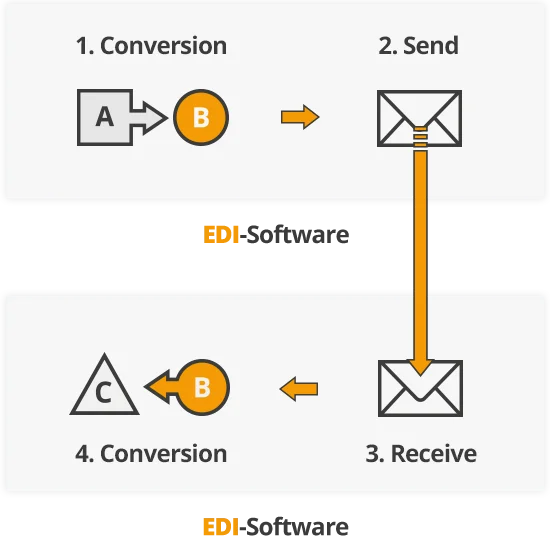
EDI message formats
Depending on the industry and the application, different exchange formats are required. The format most frequently required in Europe is certainly the EDIFACT format developed by the UN/ECE. Based on this format, there are a number of so-called subsets, which were created by industry associations and are therefore mainly used within a specific industry. The best known subset of an EDIFACT message standard is the EANCOM format of GS1. In addition to the EDIFACT data format, other EDI data formats exist, including ANSI X.12, ODETTE, OPENTRANS, ZUGFeRD and others.
Often an industry association or the partner specifies the desired data format with the EDI connection.
List of the most common EDI data formats:
- CSV
- Factur.X
- FLATFILE
- TRADACOMS
- SAP IDOC
- X12
- XRECHNUNG
- ZUGFeRD
- XML
List of EDI transmission protocols:
- AS2
- SFTP/FTP/FTPS
- HTTP
- OFTP2
- SOAP
- X.400
How is a file generated in EDI format?
A so-called EDI converter transforms the data from the source - also called interface - into the message format required by the recipient, e.g. EDIFACT. In EDI parlance, these implementations are also called EDI connectors, because the EDI software connects to the interface of the ERP/WWS. Specifically, the connection ensures that when an order is created in the ERP, an EDI file is also generated in the background.
How does the EDI file get to the partner? Communication standards for EDI implementation
Similar to the data formats, there are also industry-typical EDI exchange protocols for the transport protocols. The most prominent example of an industry-specific communication protocol is certainly the OFTP2 protocol, which is used primarily in the automotive sector. In other industries, such as retail or energy, AS2 is the most commonly used protocol. In modern communication protocols, encryption, signature and acknowledgement of the transmission status of the message play a key role.
EDI before ↔ after
In summary, the previously paper-based exchange of documents will be digitized and thus also automated. As a result, an order sent via EDI will appear immediately in the supplier's merchandise management system without any manual intervention by an employee.
Paper process
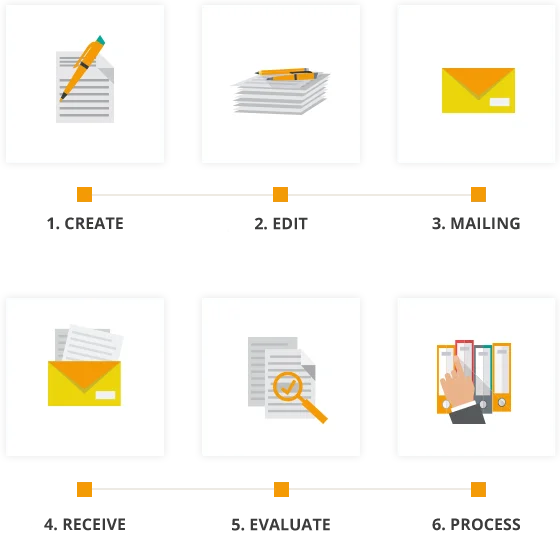
EDI-Prozess(Format A: ERP-Konnektor)
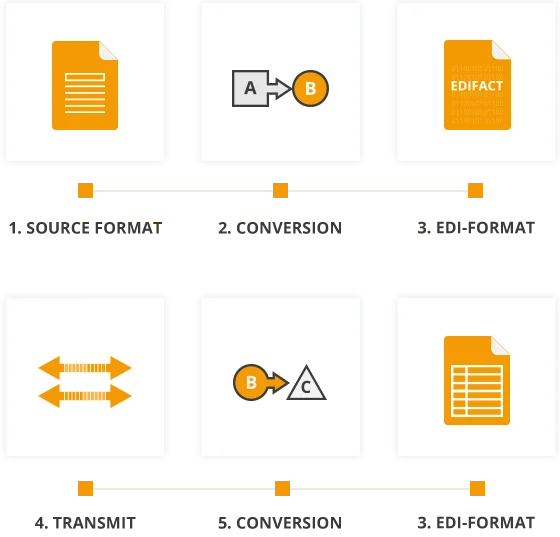
Advantages of EDI
Digitalization and with it the ability to react quickly to changing IT requirements on the market are essential today. The ability to exchange business documents with customers and suppliers also via EDI is of central importance for some companies. As the business processes of many industries depend on further optimization of processes due to increased costs or competition, EDI plays a central role. EDI improves the efficiency and effectiveness of business processes. EDI is automated and therefore neither time-delayed nor dependent on human resources.
In summary, EDI provides the following benefits:
What is needed to implement EDI? or: How do I carry out an EDI connection?
For a quick and easy EDI connection of business partners, the use of an EDI solution is particularly helpful, as it already contains many of the required functionalities and facilitates the setup of the EDI processes. With the help of standard software, the necessary steps in EDI operations do not have to be programmed by the company itself, but only configured. EDI systems come in two different forms: The on-premise and the cloud variant (EDI clearing). Both variants have certain advantages and disadvantages depending on the application.
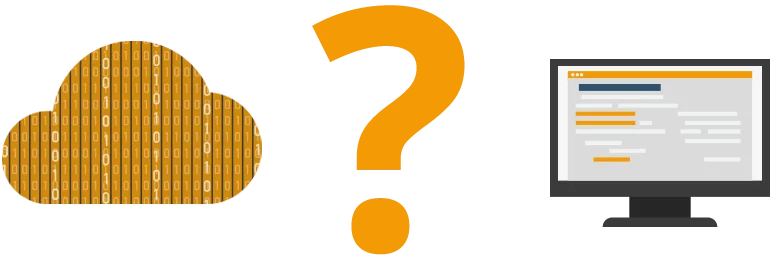
To set up the EDI process with a partner, the source or destination for the data must first be defined. This is often referred to as the "in-house interface". This can be a database table or a text file that contains the information to create or process the business document. A number of enterprise resource planning systems or ERPs already have these EDI interfaces out of the box. In the case of systems that are highly customized to the company, the interfaces often still need to be prepared for EDI use. At this point, the system administrator helps to identify & configure the right interface for the EDI system.
4 Criteria for EDI start-up:
- • ERP/WWS connector, also called interface: Source and destination for the data.
- • GLN or unique identifier - optionally GTIN for item identification.
- • At least one supported communication protocol & message standard.
- • EDI software or EDI provider for conversion and transport of EDI messages.
EDI Onboarding in detail: The 3 Point Plan:
1. Reconciliation
- Agreement on the number and type of EDI message types to be exchanged.
- Agreement on a common EDI message standard and file format.
- Agreement on a transport protocol
2. Test phase
- Implementation of the connector to ERP or merchandise management (file or database interface).
- Test of the transport protocol "smoke test": file sending and receiving.
- Processing test of the messages - verification of the data.
- Test of as many characteristics of the messages as possible.
3. Go-live
- Coordination of dates for the changeover to EDI operation
- Observation phase: Additional manual control of the first messages for correct processing
The choice of the suitable EDI operating model
In order to understand how to select suitable EDI software, it is first necessary to define the term EDI software. EDI software is understood to be those software components that enable companies to exchange EDI messages with other companies. In doing so, the EDI software performs the conversion and transport tasks. It converts the data into the desired form and sends and receives them. These activities must be performed by the software and monitored in day-to-day operations.
Basically, there are two operating modes between which a distinction can be made: The on-premise and the cloud variant. In addition to the question of ownership and the associated dependence on a provider, the choice of operating mode is often also a question of data security and thus data sovereignty.
EDI on-premise variant
With the on-premise variant, the EDI solution is operated by the company on its own or rented infrastructure and is therefore usually also managed itself. However, with the on-premise variant, there are also hybrid support models in which the software provider also takes over the support and management of the EDI software. The biggest advantage of choosing the on-premise mode over the cloud is the low dependency on the provider and the data sovereignty.
New connections or requirements from EDI partners can be realized by the company itself at short notice without any dependency on the provider's personnel resources. In fact, the opposite is true: EDI tasks can be completed in-house as long as the necessary internal resources are available. If the company's own resources do run short, the EDI software provider can be called in to quickly implement important changes or new requirements.
In addition to speed and flexibility in the case of new requirements, data security is also a key argument in favor of in-house operation of the EDI solution. With on-premise, EDI is operated in a company's own data center and thus on its own hardware: This ensures the location and, above all, the access restriction to the sensitive company data, some of which can be found in an EDI file.
Last but not least, the guarantee of a long operating life is also ensured. EDI software, once set up, is often operated for many years, usually for about 5-15 years. In such cases, the on-premise solution is often the more suitable variant, as the costs for this are already amortized after a few years. In contrast to the cloud variant, it can continue to be operated at the same cost even if the provider's price or service model changes.
EDI Cloud Service/EDI Clearing/EDI Managed Service
In the cloud variant, an EDI solution from a provider is used to perform the EDI tasks. In this case, it is not necessary to install the EDI software on your own hardware. The EDI software - often referred to as EDI platform in the cloud - is accessed via the Internet in a browser. Monitoring, administration and new setups are often carried out through standardized views and with the help of wizards. The biggest advantage of EDI cloud solutions is the quick setup of EDI standard cases, which are already used by many other customers.
However, behind this advantage often lies one of the biggest disadvantages of the cloud variant: It is not as easy and quick to adapt to one's own requirements, especially if the in-house or EDI interface differs greatly from the standard and is not supported in this way on an ad-hoc basis.
The choice of a cloud solution is preferred by many companies when entering EDI because the operating and setup costs are initially very low. However, since the costs and, above all, the dependency on the platform increase with increasing use and scaling, a precise cost calculation must be made in every case over the entire period of use.

Contact
We will be happy to advise you personally and compile
an individual concept with you. Request now without obligation.
